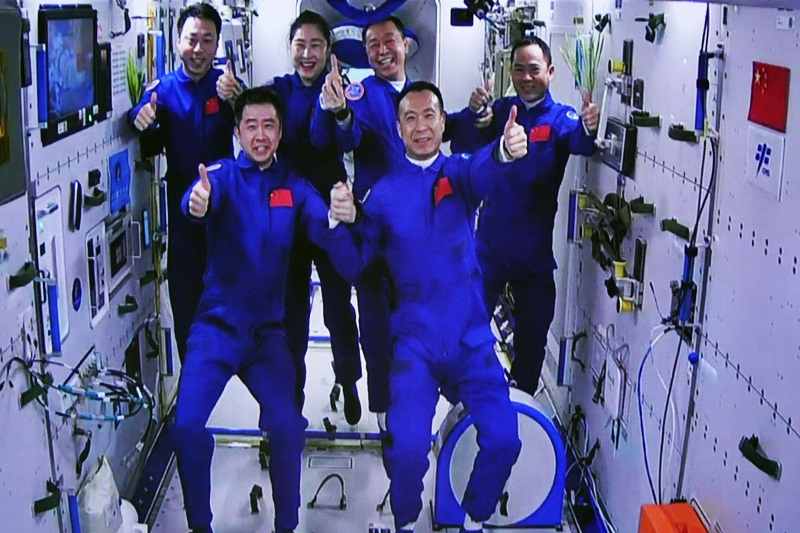
In this photo released by Xinhua News Agency, an image captured off a screen at the Jiuquan Satellite Launch Center in northwest China shows the Shenzhou-15 and Shenzhou-14 crew taking a group picture with their thumbs up after a historic gathering in space on Wednesday, Nov. 30, 2022.
12:42 JST, November 30, 2022
China on Tuesday launched a trio of taikonauts to its recently completed space station, another significant milestone for a country that has big ambitions in space and is rivaling the prowess of the United States.
The launch from the Jiuquan Satellite Launch Center in northwest China lifted off at 10:08 a.m. Eastern time. On board the Long March 2F rocket were Fei Junlong, Deng Qingming and Zhang Lu.
The launch was deemed a “complete success,” by an official in the Chinese mission control center, where flight engineers broke into applause after the Shenzhou-15 mission spacecraft unfurled its solar arrays and was flying freely toward the space station. It is expected to dock with the station later on Tuesday.
China touted the launch as another sign of its technological prowess, providing a live stream to the mission, narrated in English and with views of the three taikonauts inside the capsule, and providing special access to the launch center to the New York Times and Japan’s Kyodo News.
China recently completed the construction of its Tiangong space station, located in low Earth orbit. The crew would spend six months there, overlapping with another crew of three for a few days. China has been assembling its space station for the past couple of years, giving its taikonauts a foothold in space and a platform to perform science experiments.
The Chinese space station is being developed at a time when the International Space Station that the United States and Russia operate together is aging, though NASA hopes to continue to use it through 2030. China is not a partner in the ISS, and NASA is barred by law from partnering with China on space activities without specific congressional authorization. NASA is looking to the private sector to build stations to replace the ISS after it is decommissioned, but is not clear they will be ready in time.
In recent years, China has made significant progress on its own, landing a spacecraft on the far side of the moon in 2019, as well as a rover on Mars last year.
China also has plans to send people to the moon, an effort that would rival NASA’s lunar campaign, known as the Artemis program. That has touched off concern in the United States, which has sought to update rules, known as the Artemis Accords, that would govern behavior in space and on the surface of the moon and other celestial bodies. Both China and the U.S. are interested in exploring the lunar south pole, where there is water, in the form of ice, in the permanently shadowed craters.
In the decades since the Apollo program, NASA’s deep space human exploration progress has moved in fits and starts with different presidential administrations giving NASA different targets, from the moon, to Mars, then an asteroid, then back to the moon again. China, meanwhile, has moved slowly and steadily toward its goals.
A human landing would “not take a long time,” Zhou Jianping, the chief designer of China’s human space program, told the Times in an interview. “We can achieve the goal of manned moon landing.”
Tensions between China and the U.S. have been mounting. Recently, NASA Administrator Bill Nelson chastised China after another of its rocket stages fell back uncontrollably to Earth. “It is critical that all spacefaring nations are responsible and transparent in their space activities and follow established best practices, especially, for the uncontrolled re-entry of a large rocket body debris – debris that could very well result in major damage or loss of life,” he said in a statement.
Nelson has said China is a “a very aggressive competitor” that has big ambitions in space and is challenging America’s leadership. “Watch the Chinese,” he warned last year.
His rhetoric has matched that of former Vice President Mike Pence, who pushed NASA to return astronauts to the lunar surface on an expedited timeline. He warned that China was trying “to seize the lunar strategic high ground and become the world’s spacefaring nation.”
NASA has recently made significant progress with its Artemis program. Earlier this month, the space agency launched the massive Space Launch System from the Kennedy Space Center in Florida, hoisting the Orion spacecraft into orbit around the moon. The mission, which has no astronauts on board, is a test flight in preparation for flying astronauts to lunar orbit and eventually to the surface of the moon.
So far, NASA has said, the flight has gone exceeding well. The mission “has had extraordinary success and has completed a series of history making events,” Nelson told reporters Monday.
"News Services" POPULAR ARTICLE
-

American Playwright Jeremy O. Harris Arrested in Japan on Alleged Drug Smuggling
-

Japan’s Nikkei Stock Average as JGB Yields, Yen Rise on Rate-Hike Bets
-

Japan’s Nikkei Stock Average Licks Wounds after Selloff Sparked by BOJ Hike Bets (UPDATE 1)
-

Japan’s Nikkei Stock Average Buoyed by Stable Yen; SoftBank’s Slide Caps Gains (UPDATE 1)
-

Japanese Bond Yields Zoom, Stocks Slide as Rate Hike Looms
JN ACCESS RANKING
-

Keidanren Chairman Yoshinobu Tsutsui Visits Kashiwazaki-Kariwa Nuclear Power Plant; Inspects New Emergency Safety System
-

Imports of Rare Earths from China Facing Delays, May Be Caused by Deterioration of Japan-China Relations
-

University of Tokyo Professor Discusses Japanese Economic Security in Interview Ahead of Forum
-

Tokyo Economic Security Forum to Hold Inaugural Meeting Amid Tense Global Environment
-

Japan Pulls out of Vietnam Nuclear Project, Complicating Hanoi’s Power Plans





















